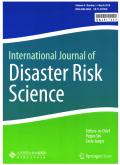考虑洪水风险降低与移民影响的吴溪口综合防洪工程成本效益分析
IF 4
2区 地球科学
Q2 GEOSCIENCES, MULTIDISCIPLINARY
引用次数: 0
摘要
摘要洪水灾害风险管理项目的经济成本和效益评价至关重要。然而,目前的成本效益分析(CBA)往往缺乏对防洪措施预期损失减少的可靠估计,并且忽略了对重新安置的定量评估。为了解决这些局限性,本研究以江西省吴溪口综合防洪工程为例,将概率风险分析方法和定量移民效益评估纳入CBA框架。综合水文统计、洪水淹没数值模拟、定量破坏分析和暴露易损性数据,估算了防洪的直接经济效益。此外,根据对家庭就业的假设,通过衡量移民的年收入增长来量化安置收益。我们的分析表明,按2020年价格计算,该项目总投资为3.546亿元人民币(1美元= 6976元人民币),其中贷款本息2.444亿元,运营维护6.055亿元人民币。据估计,该项目每年可减少洪水风险3.513亿元,增加安置收入1.557 - 1.919亿元,增加水电收入4270万元。考虑整个项目生命周期的成本和收益,内部收益率为13.7% - 14.2%,净现值为318 - 3526亿元。通过改进的效益估算方法,本研究能够更可靠、更全面地评估洪水风险管理项目的成本和效益。它为参与类似项目的决策者和从业人员提供了见解,有助于在洪水灾害风险管理方面做出更明智的决策,更好地分配资源。本文章由计算机程序翻译,如有差异,请以英文原文为准。
Cost-Benefit Analysis of the Wuxikou Integrated Flood Management Project Considering the Effects of Flood Risk Reduction and Resettlement
Abstract Evaluation of the economic costs and benefits of flood disaster risk management projects is crucial. However, current cost-benefit analyses (CBA) often lack reliable estimates of the expected loss reduction from flood control measures and ignore quantitative assessments of resettlement. To address these limitations, this study incorporated a probabilistic risk analysis method and quantitative resettlement benefits assessment into the CBA framework, using the Wuxikou Integrated Flood Management Project (WIFMP) in Jiangxi Province, China, as a case study. The direct economic benefits of flood control were estimated by integrating hydrological statistics, numerical flood inundation simulation, and quantitative damage analysis with exposure and vulnerability data. Furthermore, the resettlement benefits were quantified by measuring the annual income growth of migrants based on assumptions about household employment. Our analysis shows that the total WIFMP investment is RMB 3546.1 million yuan (USD 1 = RMB 6.976 yuan), including loan principal and interest of 244.4 million yuan, and operations and maintenance of 605.5 million yuan at 2020 prices. Annual project benefits are estimated at 351.3 million yuan in flood risk reduction, 155.7–191.9 million yuan from increased resettlement income, and 42.7 million yuan in power and water revenues. Considering the costs and benefits across the entire project lifecycle, the internal rate of return ranges from 13.7 to 14.2%, and the net present value ranges from 31.8 to 352.6 billion yuan. Through improved benefit estimation methodology, this research enables a more reliable and holistic evaluation of costs and benefits for flood risk management projects. It provides insights for policymakers and practitioners involved in similar projects, contributing to more informed decision making and better allocation of resources in flood disaster risk management.
求助全文
通过发布文献求助,成功后即可免费获取论文全文。
去求助
来源期刊

International Journal of Disaster Risk Science
GEOSCIENCES, MULTIDISCIPLINARYMETEOROLOGY-METEOROLOGY & ATMOSPHERIC SCIENCES
CiteScore
6.50
自引率
7.50%
发文量
63
审稿时长
13 weeks
期刊介绍:
The International Journal of Disaster Risk Science (IJDRS) provides a pioneering platform for researchers and practitioners aiming at greater resilience and integrated risk governance in view of local, regional, and global disasters. IJDRS breaks new ground in research about disaster risks by connecting in-depth studies of actual disasters and of specific practices of disaster risk management with investigations of the global dynamics of disaster risks and theories and models relevant for advanced integrated risk governance.
 求助内容:
求助内容: 应助结果提醒方式:
应助结果提醒方式:


